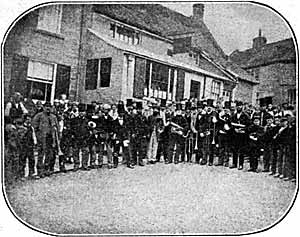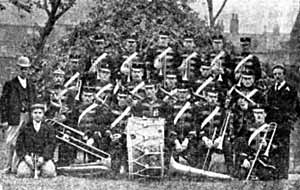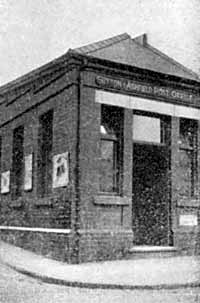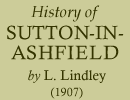< Previous | Contents | Next >
SUTTON FIRE BRIGADE.
 |
Strange, but true! Until November, 1906, the town with its population of about 20,000 souls, and with its several large hosiery factories and other manufactories, planted in the very midst of the most thickly-populated areas, together with a number of substantially-built business establishments and residences, was without an organised Fire Brigade. But, as satisfactory as it may even now seem, it is not yet fully equipped—what is still needed to make it a complete and up-to-date organisation being a small Shand-Mason steamer. Its apparatus at present consists of—One Running-out Cart, Two Stand Pipes, Four Clay Pipes, Two Hydrant Keys and 14 Lengths of Hose Pipe. Each Fireman is called together by Telephone from the Urban District Council's depot in Church Street, where the uniforms of the firemen are kept, and practices are indulged in fortnightly. The services of the brigade may be obtained for outbreaks in the immediate districts on payment of a fee. Fire Boxes are fixed in various parts of the town as follows:—High Pavement (near to the Shakespeare Inn), Bowne Street and at Eastfield Side (near to Messrs. F. Tudsbury & Sons' hosiery factory). Each box contains 3 Lengths of Hose Pipe 3 Minimax Fire Extinguishers, 1 Stand Pipe, 1 Clay Pipe, and a Key. The names of the above are—G. Beeves (Captain), W. Straw, G. Jackson, J. Miller, G.Bevill, W. Barnett, J. Marriott, and C. Blackwell (since resigned, his place having been filled by J. W. Blyton). For fires the firemen are paid:—Captain, 10s. and 2s per hour after first four hours; firemen, 2s.6d. first hour and 1s 6d. per hour afterwards. For practices: Captain, 5s.; firemen. 2s. 6d.
PARLIAMENTARY. Since 1900, Mr. A. B. Markham, M.P., of Stuffynwood Hall, near Mansfield, a large colliery owner, has represented Sutton-in-Ashfield in Parliament (per the Mansfield Parliamentary Electoral Division). He succeeded Mr. J. Carvell Williams, M.P., who retired after having represented the division for several years previously, beating the late Col. Eyre, C.B., at the poll. The latter unsuccessfully contested two general elections. In 1906. Mr. Markham was returned unopposed.
SUTTON'S INSTRUMENTALISTS.
 |
In 1864—Scott A Limb's and Denman's Head Bands (combined). Scene ... Market Plan. Almost since its existence, Sutton has had its organisations of instrumentalists, but it was not practically until upwards of half-a-century ago that it gained its renown in that sphere For many years subsequently the town became famous for its brass bands, combined with glee singers, and engagements were then far more popular with the Suttonians than they are to-day. At that period the town, even with only its few thousand inhabitants, could boast of no less than half-a-dozen combinations, whilst to-day, with its 18,000, it has only two—being the Old Model Prize and Temperance Prize. To compare the style of appearance of the respective bands at the different periods from the illustrations will bo somewhat interesting. For contests and special engagements, the members of the respective bands in the sixties frequently combined. The names of the above are—B Scott (conductor of Scott & Limb's), Jas. Handley, E. Dennis, S Cauldwell, H. Oscroft, E. Handley, S. Hall, W. Green, A. Caunt J. Naylor (well-known as "Spring"), W. Bryan, G. Scott S. Oldham, J. Searson, E. Limb, and Jos. Dennis (conductor of Denman's Head). There are doubtless many inhabitants alive to-day who will be able to recall to mind those of that band who have gone to their long rest many years ago. B. Scott, W. Bryan, and J. Searson are the only survivors to tell the tale!
 |
In 1906—The Temperance Prize Band.Scene ... Rear of Osiman House, High Pavement. |
The above bandsmen are:—B. Elliott, F. Perrin, A. Whetton, C. Whitehead, F. Simms. J. W. Shaw, W. Davies, J. Booth, H. Heath (Treasurer), W. Searson, M. Turner, C. Wells, J. Attewell (Bandmaster, of Kirkby-in-Ashfield), H. Minchan (Assistant Bandmaster), G Lane, S. Williamson. H. Clarke, A. Lane, C. Dove, I. Gough (Secretary), B. Smith, and R. Vaughan.
A BANDSMAN'S FATALITY.
The only serious mishap which ever attended any of the engagements of any of the Sutton bands was the one in connection with the Old Model Prize Band in 1876. As the band was returning from the Belper "Tap Dressing" Festival in the evening of July 5th of that year, one of their members—Charles Searson, of Crown Street—by some means or other fell off the brake on to the ground, near to the spot where the old toll-bar was located on South Normanton Common, killing him almost instantaneously. He was only 38, and his untimely demise under such sad circumstances was deeply deplored by his fellow bandsmen.
INDEPENDENT LABOUR PARTY.
This organisation was started in 1897 and now has a membership of 26. Mr. S. Fortune, of St. Michael Street, is secretary; Mr. A Lupton president; and Messrs. H. Bristol, Fitz Patrick, and T. Bristol the executive. It is affiliated to the National I.L.P., to which it pays a monthly fee of 1d. per member, in common with other branches. It is also affiliated to the Nottingham and District Federation of I.L.P. branches. It is represented on the Urban District Council by Messrs. G. A. Spencer and A. Lupton—returned at the 1907 election.
THE POST OFFICE.
 |
The Post Office, like many other things in the town, had a very humble beginning, one of its early homes being at the house now occupied by Mr. F. Riley in Market Street (until recently known as Little Lane). It is not one of the most attractive or commodious buildings even now! That was in the year 1842, and at that period the mails, both incoming and outgoing, were transferred to Alfreton and Mansfield per mail van. In those days there was not a universal penny postage, but there was, however, a penny postage between Sutton and Mansfield. Sums varying from 3d. to 1s. were paid by the inhabitants for missives received from places further afield. Thanks, therefore, for the universal penny postage! As may be imagined, there was not a numerous collection of letters upwards of 60 years ago, and whereas even up to a comparatively short time ago a single postman performed the delivery of letters in the parish, the work has so rapidly increased in recent years that the staff now numbers 8 regular postmen, 3 substitutes, and 2 telegraph messengers. It is interesting to record that the first postmaster in the town was the late Mr. Charles Plumbe, appointed in 1837, who was an esteemed friend of the late Dr. Spencer T. Hall—one of Sutton's celebrities—and who. in the course of time, played no unimportant part in the development and well-being of the parish. After a few years at the above address, the office found a new home in the Market Place—at the premises now owned by the Mansfield and Sutton Co-operative Society—Mr. Plumbe having removed thither for the more convenience of carrying on the joint postal and printing businesses which he had in hand. The latter relinquished his position as postmaster on being appointed postmaster of Mansfield in 1868, and on the appointment of the late Mr. S. Littlewood, chemist, the postal work was transferred to its present home. In 1883, Mr. Littlewood passed away, and Messrs Wharmby and Phillips purchasing the chemistry business, the last-named superintended the postal work until the partnership was dissolved in 1884. On December 9th of that year the present postmaster (Councillor Geo. Stevenson) commenced his duties, and the work is now being ably carried on by him. The office, as shown on the previous page, was opened October 16th, 1892, the cost, which was borne by the postmaster, being £120. Up to the erection of the present building the postal and chemistry businesses were conducted over the same counter.
The office is open from 7 a.m. to 8-15 p.m. each day (except Sundays) for the sale of Stamps, and from 8 a.m. to 8 pm. for the transaction of P.O.O., P.O., and Savings Bank business.
Dispatches: 9-20 and 11-45 a.m.; 3-45, *7-40, and 8-15 p m.
Deliveries : 7-15 a.m., and 2-15 and 6-15 p.m.
* For Scotland, Ireland, Lancashire, and North Wales.
The office is situated at the junction of King Street, New Street, and the Market Place. There are three Pillar Posts in the town—Devonshire Square Kirkby Road. and Forest Street; and Wall Boxes at West End, Hucknall Road, New Cross Post Office (Mr. J. Stanley's), Mansfield Road (New Cross), and Forest Side Post Office.
RAILWAYS.
There are three railway stations in the town. The Town Midland Railway Station in Forest Street was opened May 1st, 1893, when the members of the old Local Board—(chairman, the late Mr. M. Jarvis)—were present and indulged in the "first run" to the Junction in the saloon provided by the Company for the formal opening. It stands on the site which was known as "Clarke's Croft," and on which celebrated cricket matches between Sutton and All England Elevens were played. The Junction Station was opened October 12th. 1850 The Great Northern Station in Outram Street was opened for goods traffic on March 1st, 1898, and for passenger on April 4th. 1898. A memorable banquet was held on the latter date in the Town Hall when several hundred tradesmen, manufacturers, and other gentlemen were present. The local arrangements for that gathering were made by Mr. A. H. Bonser, J.P. The Mansfield & District Light Railways' Company, Ltd., opened the Sutton section of their lines Dec., 19, 1905, and the Huthwaite section Feb. 17th, 1906. An effort is now being made by the Sutton Urban District Council, together with others, to induce the Great Central Railway Company to construct a line through the parish and erect a station in the town.
< Previous | Contents | Next >
